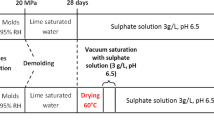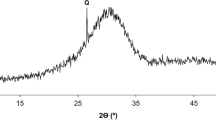Abstract
Concrete made from rapid sulphoaluminate cement is widely used today, especially in China. It is likely to continue gaining popularity since its manufacture produces less CO2 than the process of manufacturing ordinary Portland cement. Elevated temperatures are among the most serious threats to the structural stability of this product. In the present study, laboratory tests were carried out, through Rietveld analysis and other systematic testing, on samples of hardened rapid sulphoaluminate cement paste exposed to six different temperatures. As the temperature increased, the content of minerals that contribute to rapid sulphoaluminate cement strength was reduced. There was also an increase in porosity. The results show that the chemical dehydration of rapid sulphoaluminate cement after exposure to elevated temperatures is great enough to increase the local pores’ absorption, a change that can be fatal to rapid sulphoaluminate cement concrete’s strength. This understanding could help us characterize strength reduction in a more effective manner, not just in laboratory samples but also in actual structures containing rapid sulphoaluminate cement that has been exposed to elevated temperatures.
















Similar content being viewed by others
References
Yeih W, Chang JJ. The influences of cement type and curing condition on properties of pervious concrete made with electric arc furnace slag as aggregates. Constr Build Mater. 2019;197:813–20. https://doi.org/10.1016/j.conbuildmat.2018.08.178.
Shen Y, Qian J, Chai J, Fan Y. Calcium sulphoaluminate cements made with phosphogypsum: production issues and material properties. Cement Concr Compos. 2014;48:67–74. https://doi.org/10.1016/j.cemconcomp.2014.01.009.
Hou W, Liu Z, Hec F, Huang J, Zhou J. Sulfate sulphoaluminate diffusion in calcium mortar. Constr Build Mater. 2020;234: 117312. https://doi.org/10.1016/j.conbuildmat.2019.117312.
Ge Z, Yuan H, Sun R, Zhang H, Wang W, Qi H. Use of green calcium sulphoaluminate cement to prepare foamed concrete for road embankment: a feasibility study. Constr Build Mater. 2020;237: 117791. https://doi.org/10.1016/j.conbuildmat.2019.117791.
Zhang G, Yang Y, Yang H, Li H. Calcium sulphoaluminate cement used as mineral accelerator to improve the property of Portland cement at sub-zero temperature. Cement Concr Compos. 2020;106: 103452. https://doi.org/10.1016/j.cemconcomp.2019.103452.
Min D, Beibei L. Decomposition and reconstruction of synthetic ettringite. J Shenyang Jianzhu Univ (Natural Sci). 2019;5:35. https://doi.org/10.11717/j.issn:2095-1922.2019.05.17.
Telesca A, Marroccoli M, Pace ML, Tomasulo M, Valenti GL, Monteiro MPJ. A hydration study of various calcium sulfoaluminate cements. Cement Concr Compos. 2014;53:224–32. https://doi.org/10.1016/j.cemconcomp.2014.07.002.
American Concrete Institute. ACI216.1. In: Code requirements for determining fire resistance of concrete and masonry construction assemblies, ACI 216.1-07/TMS-0212-07. 2007, Farmington Hills, Mich., USA. 2017.
American Concrete Institute. In: ACI-318. Building code requirements for reinforced concrete and commentary. 2008, Farmington Hills, Mich., USA. 2008.
Shi C, Jimenez AF, Palomo A. New cement for the 21st century: the pursuit of an alternative to Portland cement. Cement Concr Res. 2011;41:750–63. https://doi.org/10.1016/j.cemconres.2011.03.016.
Sanfelix SG, Zea-García JD, Londono-Zuluaga D, Santacruz I, De la Torre AG, Kjøniksen AL. Hydration development and thermal performance of calcium sulphoaluminate cements containing microencapsulated phase change materials. Cement Concr Res. 2020;135: 106039. https://doi.org/10.1016/j.cemconres.2020.106039.
Gallardo MH, Almanza JMR, Cortés DAH, Escobedo JCB. Mechanical and chemical behavior of calcium sulfoaluminate cements obtained from industrial waste. ALCONPAT J. 2016;6:15–27. https://doi.org/10.21041/ra.v6i1.112.
Eik M, Antonova A, Puttonen J. Phase contrast tomography to study near-field effects of polypropylene fibres on hardened cement paste. Cement Concr Compos. 2020;114:2014103800. https://doi.org/10.1016/j.cemconcomp.2020.103800.
Chu SH. Effect of paste volume on fresh and hardened properties of concrete. Constr Build Mater. 2019;218:284–94. https://doi.org/10.1016/j.conbuildmat.2019.05.131.
Aranda MAG, De la Torre AG. Sulfoaluminate cement. Civ Struct Eng. 2013;18:488–522. https://doi.org/10.1533/9780857098993.4.488.
Stutzman PE, Feng P, Bullard JW. Phase analysis of Portland cement by combined quantitative x-ray powder diffraction and scanning electron microscopy. Res Natl Inst Stand Technol. 2016;2016:121. https://doi.org/10.6028/jres.121.004.
Pimraksa K, Chindaprasirt P. Sulfoaluminate cement-based concrete. Eco-efficient repair and rehabilitation of concrete infrastructures. Civ Struct Eng. 2018;12:355–85. https://doi.org/10.1016/B978-0-08-102181-1.00014-9.
Fernández-González D, Prazuch J, Ruiz-Bustinza I, González-Gasca C, Piñuela-Noval J, Verdeja LF. Solar synthesis of calcium aluminates. Sol Energy. 2018;171:658–66. https://doi.org/10.1016/j.solener.2018.07.012.
Tchekwagep JJK, Wang S, Mukhopadhyay AK, Huang S, Cheng X. Strengths of sulphoaluminate cement concrete and ordinary portland cement concrete after exposure to high temperatures. Ceram Silikáty. 2020;64:225–36. https://doi.org/10.13168/cs.2020.0012.
Raut NK, Kodur VKR. Response of high-strength concrete columns under design fire exposure. J Struct Eng. 2011;137:69–79. https://doi.org/10.1061/-asce-st.1943-541x.000026.
Zhang L, Glasser FP. Hydration of calcium sulfoaluminate cement at less than 24 h. Adv Cem Res. 2015;14:141–55. https://doi.org/10.1680/adcr.2002.14.4.141.
Sandananda SAHU, Majling J. Preparation of sulphoaluminate belite cement from fly ash. Cement Concr Res. 1994;24:1064–72. https://doi.org/10.1016/0008-8846(94)90030-2.
Khaliq W, AnisKhan H. High temperature material properties of calcium aluminate cement concrete. Constr Build Mater. 2015;94:475–87. https://doi.org/10.1016/j.conbuildmat.2015.07.023.
Zapata JF, Gomez M, Colorado HA. High temperature cracking damage of calcium aluminate cements. Miner Metals Mater Ser. 2018;2018:553–63. https://doi.org/10.1007/978-3-319-72526-0_52.
Tchekwagep JJK, Wang S, Mukhopadhyay AK, Huang S, Cheng X. Compressive strength of rapid sulfoaluminate cement concrete exposed to elevated temperatures. Ceram-Silikáty. 2020;64:299–309. https://doi.org/10.13168/cs.2020.0019.
Zapata JF, Gomez M, Colorado HA. Calcium aluminate cements subject to high temperature. Am Ceram Soc. 2017;2017:262. https://doi.org/10.1002/9781119423799.ch10.
Zhang G, He R, Lu X, Wang P. Early hydration of calcium sulphoaluminate cement in the presence of hydroxyethyl methyl cellulose. J Therm Anal Calorim. 2018;134:1429–38. https://doi.org/10.1007/s10973-018-7252-5.
Uvarov V, Popov I. Metrological characterization of X-ray diffraction methods at different acquisition geometries for determination of crystallite size in nano-scale materials. Mater Charact. 2013;85:111–23. https://doi.org/10.1016/j.matchar.2013.09.002.
Álvarez-Pinazo G, Cuesta A, García-Maté M, Santacruz I, Losilla RE, De la Torre AG, León-Reina L, Aranda MAG. Rietveld quantitative phase analysis of Yeelimite-containing cements. Cem Concr Res. 2012;42:960–71. https://doi.org/10.1016/j.cemconres.2012.03.018.
Němeček J, Králík V, Šmilauer V, Polívka L, Jäger A. Tensile strength of hydrated cement paste phases assessed by micro-bending tests and nanoindentation. Cement Concr Compos. 2016;73:164–73. https://doi.org/10.1016/j.cemconcomp.2016.07.010.
Zingg A, Holzera L, Kaech A, Pakuschc FWJ, Becker S, Gaucklerd L. The microstructure of dispersed and non-dispersed fresh cement pastes—new insight by cryo-microscopy. Cem Concr Res. 2008;38:522–9. https://doi.org/10.1016/j.cemconres.2007.11.007.
Walenta G, Füllmann T. Advances in quantitative XRD analysis for clinker, cements, and cementitious additions. Cambridge J. 2012;47:40–4. https://doi.org/10.1154/1.1649328.
Kodur V, Raut N. A simplified approach for predicting fire resistance of reinforce concrete column under biaxial bending. Eng Struct. 2012;41:428–43. https://doi.org/10.1016/j.engstruct.2012.03.054.
Liu Z, Zhang Y, Sun G, Jiang Q. Observation of microstructure formation process of cement paste using non-destructive methods. Inst Civ Eng. 2015;64:957–65. https://doi.org/10.1680/macr.11.00149.
Dong HP, Ye GG. Characterization and comparison of capillary pore structures of digital cement pastes. Springer Nature. 2017;50:154. https://doi.org/10.1617/s11527-017-1023-9.
Moradian, M. Direct observations on microstructure evolution of cement systems at early ages. OSU Dissertations. 2017. https://doi.hdl.handle.net/11244/54578
Korpa A, Kowald T, Trettin R. Phase development in normal and ultra-high performance cementitious systems by quantitative x-ray analysis and thermoanalytical methods. Cement Concr Res. 2009;39:69–76. https://doi.org/10.1016/j.cemconres.2008.11.003.
Pressler EE, Brunauer S, Kantro DL, Weise CH. Determination of the free calcium hydroxide contents of hydrated Portland cements and calcium silicates. Anal Chem. 1961;33:877–82. https://doi.org/10.1021/ac60175a020.
Khaliq W, Khan HA. High temperature material properties of calcium aluminate cement concrete. Constr Build Mater. 2015;94:475–87. https://doi.org/10.1016/j.conbuildmat.2015.07.023.
Mirghasemi AA, Bayesteh H. Numerical simulation of tortuosity effect on the montmorillonite permeability. Procedia Eng. 2015;102:1466–75. https://doi.org/10.1016/j.proeng.2015.01.280.
TriPhung Q, Maes N, Jacops E, Jacques D, Schutter GD, Ye G. Insights and issues on the correlation between diffusion and microstructure of saturated cement pastes. Cement Concr Compos. 2019;96:106–17. https://doi.org/10.1016/j.cemconcomp.2018.11.018.
Nguyen-Ngoc H, Nguyen-Xuan H, Abdel-Wahabef M. A numerical investigation on the use of pervious concrete for seawall structures. Ocean Eng. 2020;198: 106954. https://doi.org/10.1016/j.oceaneng.2020.106954.
Beaucoura LA, Pliya P, Faleschini F, Njinwoua R, Pellegrino C, Noumowéa A. Influence of elevated temperature on properties of radiation shielding concrete with electric arc furnace slag as coarse aggregate. Constr Build Mater. 2020;256: 119385. https://doi.org/10.1016/j.conbuildmat.2020.119385.
Angelo MB, Promentilla A, Sugiyama T, Htomi T, Takeda N. Characterizing the 3D pore structure of hardened cement paste with synchrotron micro tomography. J Adv Concrete Technol. 2008;6:273–286. https://doi.eprints.lib.hokudai.ac.jp/dspace/bitstream/2115/54935.
Xu W, Chen HS. Quantitative characterization of the microstructure of fresh cement paste via random packing of polydispersed Platonic cement particles. Modell Simul Mater Sci Eng. 2012;2012:20. https://doi.org/10.1088/0965-0393/20/7/075003.
Willis KL, Abell BA, Lange AD. Image-based characterization of cement pore structure using wood’s metal intrusion. Cement Concr Res. 1998;28:1695–705. https://doi.org/10.1016/S0008-8846(98)00159-8.
Alexander S. Amorphous solids: their structure, lattice dynamics and elasticity. Phys Rep. 1998;296:65–236. https://doi.org/10.1016/S0370-1573(97)00069-0.
Baheti B, Innani S, Gajre S, Talbar S. Semantic scene segmentation in unstructured environment with modified DeepLabV3+. Pattern Recogn Lett. 2020;138:223–9. https://doi.org/10.1016/j.patrec.2020.07.029.
Oertel T, Hutter F, Helbig U, Sextl G. Amorphous silica in ultra-high performance concrete. First hour of hydration. Cement Concr Res. 2014;58:131–42. https://doi.org/10.1016/j.cemconres.2014.01.008.
Song Y, Zhou J, Bian Z, Dai G. Pore structure characterization of hardened cement paste by multiple methods. Adv Mater Sci Eng. 2019;2019:18. https://doi.org/10.1155/2019/3726953.
Zhang Q, Ye G. Microstructure analysis of heated Portland cement paste. Procedia Eng. 2011;14:830–6. https://doi.org/10.1016/j.proeng.2011.07.105.
Oertel T, Helbig U, Hutter F, Kletti H, Sextl G. Influence of amorphous silica on the hydration in ultra-high performance concrete. Cement Concr Res. 2014;58:121–30. https://doi.org/10.1016/j.cemconres.2014.01.006.
Nadir A, Yahaya FM, Yusoff M. Using high temperature for improve compressive strength of ordinary Portland cement paste (OPC)—a new approach. Adv Mater Res. 2014;894:70–6. https://doi.org/10.4028/www.scientific.net/AMR.894.70.
Mendes A, Sanjayan JG, Collins FG. Long-term progressive deterioration following fire exposure of OPC versus slag blended cement pastes. Mater Struct. 2009;42:95–101. https://doi.org/10.1617/s11527-008-9369-.
Acknowledgements
This work was supported by the National Natural Science Foundation of China (nos. 51761145023 and 51632003), the Taishan Scholars Program, and the Case-by-Case Project for Top Outstanding Talents of Jinan.
Author information
Authors and Affiliations
Corresponding author
Ethics declarations
Conflict of interest
We declare that we have no financial or personal relationships with other people or organizations that can inappropriately influence our work; there is no professional or other personal interest of any nature or kind in any product, service and/or company that could be construed as influencing the position presented in, or the review of, the manuscript entitled, “Quantitative Rietveld analysis of the decomposition of hardened rapid sulphoaluminate cement with exposure to elevated temperatures”.
Additional information
Publisher's Note
Springer Nature remains neutral with regard to jurisdictional claims in published maps and institutional affiliations.
Rights and permissions
About this article
Cite this article
Tchekwagep, J.J.K., Chen, D., Mukhopadhyay, A.K. et al. Quantitative Rietveld analysis of the decomposition of hardened rapid sulphoaluminate cement after exposure to elevated temperatures. Archiv.Civ.Mech.Eng 21, 119 (2021). https://doi.org/10.1007/s43452-021-00265-9
Received:
Revised:
Accepted:
Published:
DOI: https://doi.org/10.1007/s43452-021-00265-9




